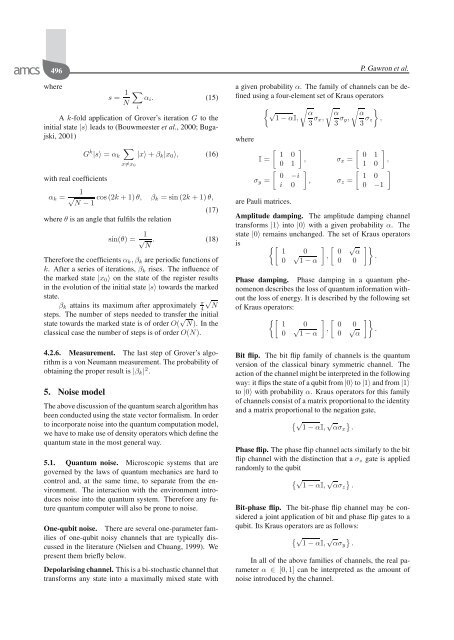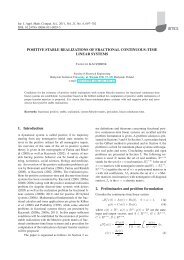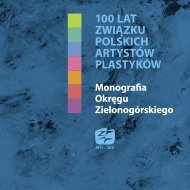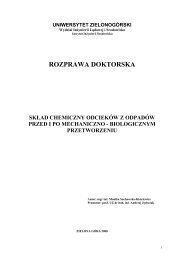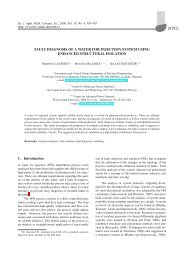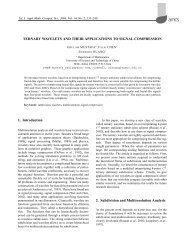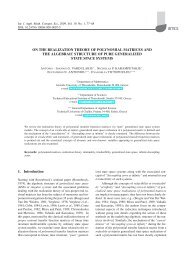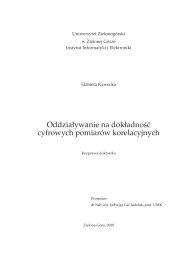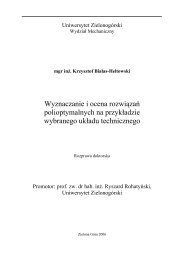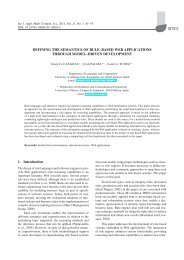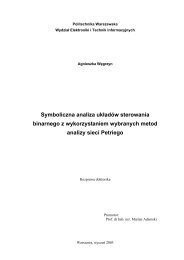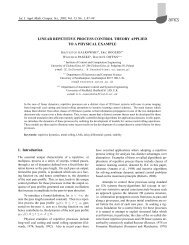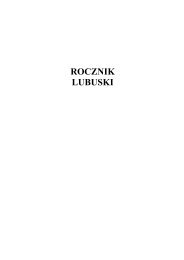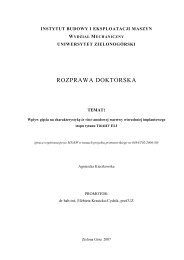NOISE EFFECTS IN THE QUANTUM SEARCH ALGORITHM FROM ...
NOISE EFFECTS IN THE QUANTUM SEARCH ALGORITHM FROM ...
NOISE EFFECTS IN THE QUANTUM SEARCH ALGORITHM FROM ...
Create successful ePaper yourself
Turn your PDF publications into a flip-book with our unique Google optimized e-Paper software.
496 P. Gawron et al.<br />
where<br />
s = 1 ∑<br />
α i . (15)<br />
N<br />
A k-fold application of Grover’s iteration G to the<br />
initial state |s〉 leads to (Bouwmeester et al., 2000; Bugajski,<br />
2001)<br />
G k |s〉 = α k<br />
∑<br />
x≠x 0<br />
|x〉 + β k |x 0 〉, (16)<br />
with real coefficients<br />
1<br />
α k = √ cos (2k +1)θ, β k =sin(2k +1)θ,<br />
N − 1<br />
(17)<br />
where θ is an angle that fulfils the relation<br />
sin(θ) = √ 1 . (18)<br />
N<br />
Therefore the coefficients α k ,β k are periodic functions of<br />
k. After a series of iterations, β k rises. The influence of<br />
the marked state |x 0 〉 on the state of the register results<br />
in the evolution of the initial state |s〉 towards the marked<br />
state.<br />
β k attains its maximum after approximately π 4<br />
√<br />
N<br />
steps. The number of steps needed to transfer the initial<br />
state towards the marked state is of order O( √ N). Inthe<br />
classical case the number of steps is of order O(N).<br />
4.2.6. Measurement. The last step of Grover’s algorithm<br />
is a von Neumann measurement. The probability of<br />
obtaining the proper result is |β k | 2 .<br />
5. Noise model<br />
The above discussion of the quantum search algorithm has<br />
been conducted using the state vector formalism. In order<br />
to incorporate noise into the quantum computation model,<br />
we have to make use of density operators which define the<br />
quantum state in the most general way.<br />
5.1. Quantum noise. Microscopic systems that are<br />
governed by the laws of quantum mechanics are hard to<br />
control and, at the same time, to separate from the environment.<br />
The interaction with the environment introduces<br />
noise into the quantum system. Therefore any future<br />
quantum computer will also be prone to noise.<br />
One-qubit noise. There are several one-parameter families<br />
of one-qubit noisy channels that are typically discussed<br />
in the literature (Nielsen and Chuang, 1999). We<br />
present them briefly below.<br />
Depolarising channel. This is a bi-stochastic channel that<br />
transforms any state into a maximally mixed state with<br />
i<br />
a given probability α. The family of channels can be defined<br />
using a four-element set of Kraus operators<br />
{ √ √ √ √1 α α α − αI,<br />
3 σ x,<br />
3 σ y, z}<br />
3 σ ,<br />
where<br />
[ ]<br />
[ ]<br />
1 0<br />
0 1<br />
I = , σ<br />
0 1<br />
x = ,<br />
1 0<br />
[ ]<br />
[ ]<br />
0 −i<br />
1 0<br />
σ y =<br />
, σ<br />
i 0<br />
z =<br />
0 −1<br />
are Pauli matrices.<br />
Amplitude damping. The amplitude damping channel<br />
transforms |1〉 into |0〉 with a given probability α. The<br />
state |0〉 remains unchanged. The set of Kraus operators<br />
is {[ 1 0<br />
0<br />
√ 1 − α<br />
]<br />
,<br />
[<br />
0<br />
√ α<br />
0 0<br />
]}<br />
.<br />
Phase damping. Phase damping in a quantum phenomenon<br />
describes the loss of quantum information without<br />
the loss of energy. It is described by the following set<br />
of Kraus operators:<br />
{[ ] [ ]}<br />
1<br />
√ 0 0 0<br />
,<br />
0 1 − α 0 √ .<br />
α<br />
Bit flip. The bit flip family of channels is the quantum<br />
version of the classical binary symmetric channel. The<br />
action of the channel might be interpreted in the following<br />
way: it flips the state of a qubit from |0〉 to |1〉 and from |1〉<br />
to |0〉 with probability α. Kraus operators for this family<br />
of channels consist of a matrix proportional to the identity<br />
and a matrix proportional to the negation gate,<br />
{√ √ }<br />
1 − αI, ασx .<br />
Phase flip. The phase flip channel acts similarly to the bit<br />
flip channel with the distinction that a σ z gate is applied<br />
randomly to the qubit<br />
{√ √ }<br />
1 − αI, ασz .<br />
Bit-phase flip. The bit-phase flip channel may be considered<br />
a joint application of bit and phase flip gates to a<br />
qubit. Its Kraus operators are as follows:<br />
{√ √ }<br />
1 − αI, ασy .<br />
In all of the above families of channels, the real parameter<br />
α ∈ [0, 1] can be interpreted as the amount of<br />
noise introduced by the channel.


